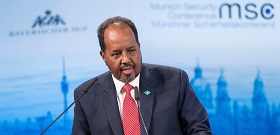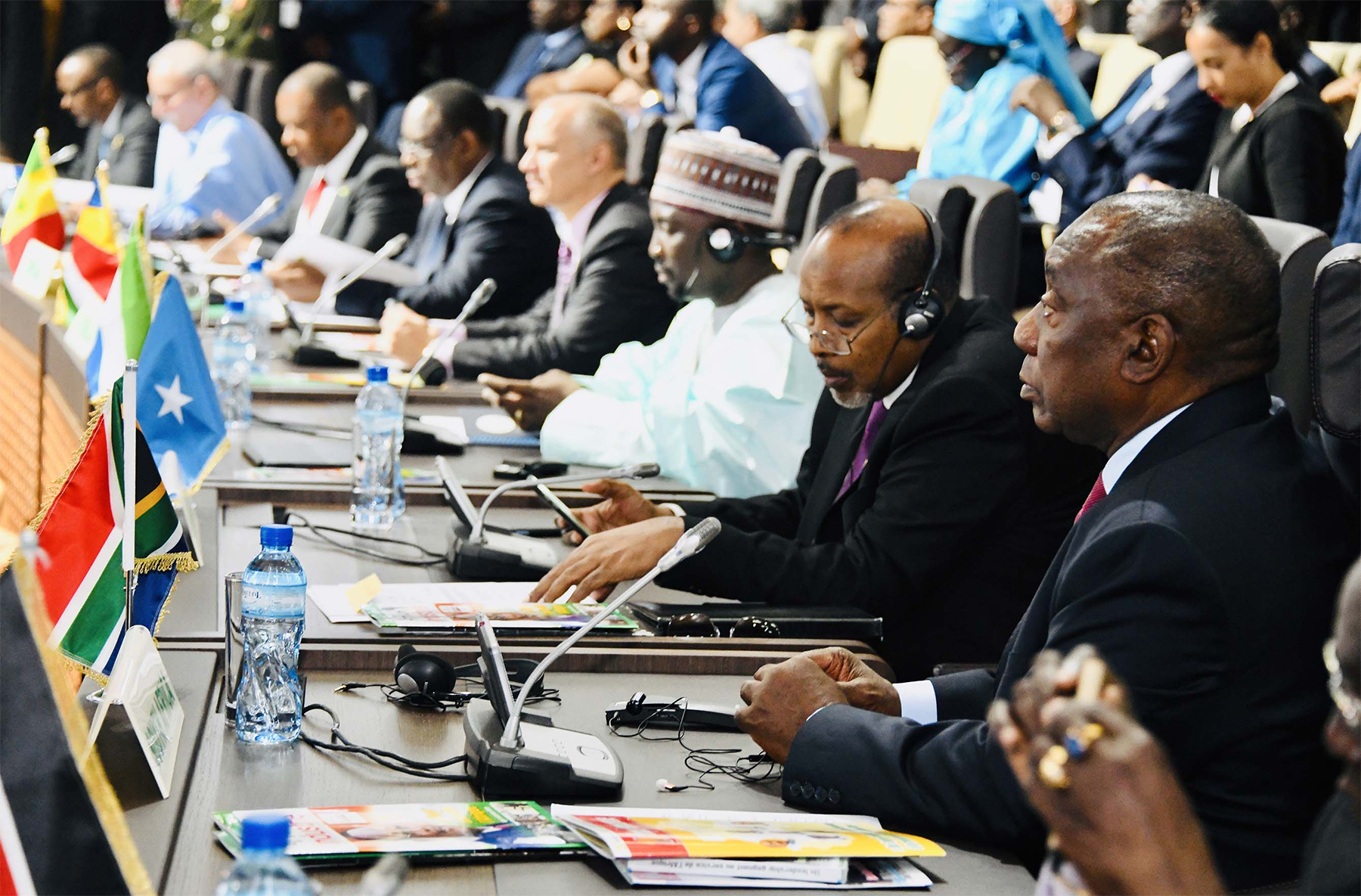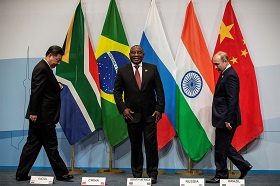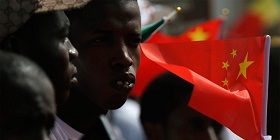The topic of Russia returning to Africa has been brought up with increasing regularity over the past 15 years. The tense of the verb is important here: Russia is returning to the continent but has not yet fully returned. This has led many to believe that Russia probably should not expect any quick progress in its policy in Africa. One might very well agree with this assessment if there was a timeline in place. However, neither those who are responsible for formulating Russia’s policy towards Africa nor those who are tasked with implementing and analyzing that policy have been able to clearly articulate precisely what Russia should do on the continent and when. Nor will they be able to at the upcoming Russia–Africa Summit. While Russia’s Policy in Africa may very well have produced certain results, there is no discernible strategy behind it. Russia’s relations with Africa were proceeding rather positively until the recent aggravation of the international situation (the Syrian Civil War, the events in Crimea and the trade war between the United States and China), but now it is advisable for Moscow to understand what Africa can offer Russia, what Russia can offer Africa, where Russia’s interests meet those of African countries and how fully Russia wants to be involved in the continent’s economic and political development.
The new international reality has laid bare the long-standing problems in Russia–Africa relations. The most glaring of these problems is that Africa is changing rapidly. Russia is thus finding it increasingly difficult to rely on its Soviet legacy. This is especially true of educational contacts. It is obvious that studying in Russia or an allied country no longer has the same significance in terms of establishing contacts with African elites and building trusting relations in the spirit of Soviet diplomacy. Africa is also changing ethnoculturally. Russia needs a completely new set of messages for its African diplomacy, because references to history (for example, to the anti-colonial struggle) may no longer work as well as before in the changing continent.
What strategy does Russia require? According to the Foreign Policy Concept of the Russian Federation to 2016, foreign policy strategy through to 2016 reads that the country is interested in “multidimensional interaction with African States” [11]. It appears that this objective would be easier to achieve by replicating the experience of India and Japan, namely, by focusing on horizontal ties, thus ensuring a powerful diplomatic presence as a tool for coordinating developmental assistance and public diplomacy. Such a strategy would be less expensive to implement than the one pursued by China, but even in this case the combined volume of development aid, loans and grants needs to be increased from the current levels. According to the Ministry of Foreign Affairs of the Russian Federation, African countries only received around $10 million from Russia in economic development aid in 2018 [12]. In addition to financial assistance (which should be provided with the help of the Russian Export Center and similar institutions), the Russian strategy needs to be careful when identifying the partner countries in Africa. Many of the major actors have tested their African strategies on a limited group of countries: Somalia in the case of Turkey; Sudan and Angola in the case of China; and East African countries in the case of India. It would seem that the Russian leadership is being cautious in this respect and is looking into the possibility of forming two test groups: large African countries (Egypt, Nigeria, and South Africa) and a group of unstable Sahel states (the Central African Republic and Sudan). Time will tell whether this approach can help Russia come up with an African strategy.
In the end, diversifying its foreign political and trade contacts is a priority for Russia in the current situation. Now is the perfect time for Russia to return to Africa, as well as to revise its goals and objectives there. The main thing to bear in mind that the situation can change very quickly.
The topic of Russia returning to Africa has been brought up with increasing regularity over the past 15 years. The tense of the verb is important here: Russia is returning to the continent but has not yet fully returned. This has led many to believe that Russia probably should not expect any quick progress in its policy in Africa. One might very well agree with this assessment if there was a timeline in place. However, neither those who are responsible for formulating Russia’s policy towards Africa nor those who are tasked with implementing and analyzing that policy have been able to clearly articulate precisely what Russia should do on the continent and when. Nor will they be able to at the upcoming Russia–Africa Summit. While Russia’s Policy in Africa may very well have produced certain results, there is no discernible strategy behind it. Russia’s relations with Africa were proceeding rather positively until the recent aggravation of the international situation (the Syrian Civil War, the events in Crimea and the trade war between the United States and China), but now it is advisable for Moscow to understand what Africa can offer Russia, what Russia can offer Africa, where Russia’s interests meet those of African countries and how fully Russia wants to be involved in the continent’s economic and political development.
The new international reality has laid bare the long-standing problems in Russia–Africa relations. The most glaring of these problems is that Africa is changing rapidly. Russia is thus finding it increasingly difficult to rely on its Soviet legacy. This is especially true of educational contacts. In Soviet times, the future elites of African countries (political functionaries, military officers, production managers, engineers and doctors) received their education in the USSR. Today, however, African graduates of Russian universities are not guaranteed employment. Russia’s current relations with Africa are for the most part very similar to the way they were in the final years of Soviet rule: just like in 1992, only three African heads of the state received an education in a Socialist bloc country [1]. Student intake is somewhat encouraging: in 2018, a total of 6781 students from Africa were enrolled in bachelor’s programs at Russian universities, while 8713 were enrolled in specialist programs and 1577 were enrolled in master’s programs. This makes over 17,000 people in total. These figures are comparable to the 1988 level, when 44,200 students from developing countries were studying in the USSR, approximately half of whom were from Africa [2]. However, it is obvious that studying in Russia or an allied country no longer has the same significance in terms of establishing contacts with African elites and building trusting relations in the spirit of Soviet diplomacy.
Africa is also changing ethnoculturally. One striking example of this change was the 2014–2018 Oromo revolution in Ethiopia, which went unnoticed by the Russian expert community. It is customary for experts to talk about Ethiopia’s special status in Russian foreign policy: the countries share a common Christian culture; Russian poet Alexander Pushkin’s great-grandfather was born in Ethiopia; and the first hospital in the country was built by the Russian Red Cross back in 1898. However, the country’s ethnopolitical balance has been changing rapidly: the southern Semitic Christian majority (represented by the Amhara, Tigre and Gurage peoples) is being replaced by the Oromo ethnic group, which now accounts for 30–40 per cent of Ethiopia’s population. This process was reflected in the transformation of the ruling party and government: under the influence of protests and bloody clashes in the state of Oromia, the Tigrinya clan lost its political and economic dominance to the Oromo bloc and the so-called southern peoples. Importantly, the Oromo are predominantly Muslim and polytheistic, so they do not care about the common Christian heritage of Russia and Ethiopia. Nor do they care about the past relations between the Russian and Ethiopian empires (not just the first hospital, but also Pushkin!): under the Ethiopian (Abyssinian) Empire, the Oromo were at the lowest rank of the social hierarchy; the teaching of their native language was all but banned; and the common name for this people was Galla (or “rejected by god” according to one theory [3]). Ethiopia is no exception in this respect: similar processes are observed in Chad, Cameroon, Benin and other African countries. Russia needs a completely new set of messages for its African diplomacy, because references to history (for example, to the anti-colonial struggle) may no longer work as well as before in the changing continent.
Another important problem has to do with the “growing pains” that Africa is currently experiencing. A total of 635 million people on the continent do not have access to electricity [4], some 330 million do not have basic access to drinking water [5], and around 240 million suffer from chronic malnutrition [6]. That said, urbanization in Africa is taking place at a very fast pace: between 1995 and 2015, the urban population doubled to more than 40 per cent of the entire population of the continent. Assuming growth rates of 3–4 per cent per year, this figure should grow to 56 percent by 2050 (some 1.3 billion people) [7]. In other words, a powerful post-industrial services sector associated with urban lifestyles is being formed in African countries right now. In sub-Saharan Africa alone, a total of 456 million unique mobile phone users were registered in 2018, and the figure is expected to exceed 600 million by 2025 [8]. The continent is transitioning towards a digital economy: 21 million online purchases worth some $2 billion in total were made in 2017 [9].
What do these contrasts mean for Russia? The situation in Africa is changing very rapidly, new opportunities and risks emerge and current business ideas lose their meaning. Those who manage to identify new opportunities and come up with ways to exploit them will gain obvious advantages. In this sense, Russia can do a lot: the country has an established system for monitoring the situation across Africa (over 40 embassies and four trade missions). It is the use of the information collected that is problematic. The Russian Export Center, set up in 2015 for the purpose of promoting non-energy exports, was expected to turn analytical materials supplied by Russian overseas representative offices into tangible proposals for the country’s exporters. However, according to 2018 reports, the centre has taken a wait-and-see approach and its functions partially overlap with those of the trade missions.
Combining monitoring with real proposals for the African market is largely a matter of strategy, because such monitoring is carried out for the purposes of achieving a certain set of long-term goals. In particular, China’s strategy involves extending affordable loans to African countries in exchange for contracts for its corporations (primarily in the energy and construction sectors). The African elites remain the main source of information for China: Chinese corporations often appease them and contribute to the construction of official government buildings and prestigious facilities (so-called concrete diplomacy) [10]. Beijing has established a powerful diplomatic presence in Africa in order to maintain such contacts, with 51 embassies across the continent. India, for its part, relies on so-called developmental diplomacy, whereby Indian business and government structures primarily focus their efforts in Africa on the least developed economic sectors of medicine, healthcare, agriculture, and telecommunications. This approach is built around the idea of intensifying bilateral public diplomacy and turning the African population itself (or at least some part of it) into a source of information. This is why India has fewer representative offices in Africa than China, with just 34 (the figure is expected to eventually reach 38). Japan’s African strategy is also of interest: Tokyo is attempting to establish B2B contacts and integrate these ties into the operation of international organizations (the UN and the World Bank). Hence the need for multi-tier diplomacy: Japan is interacting not just with African countries and businesses, but also with the continent’s integrational structures (such as the Southern African Development Community) and the representative offices of international organizations in Africa. As a result, there are 37 Japanese embassies in Africa. These examples indicate that situational monitoring cannot exist if isolated from the goals and objectives of state policy.
What strategy does Russia require? According to the Foreign Policy Concept of the Russian Federation to 2016, foreign policy strategy through to 2016 reads that the country is interested in “multidimensional interaction with African States” [11]. It appears that this objective would be easier to achieve by replicating the experience of India and Japan, namely, by focusing on horizontal ties, thus ensuring a powerful diplomatic presence as a tool for coordinating developmental assistance and public diplomacy. Such a strategy would be less expensive to implement than the one pursued by China, but even in this case the combined volume of development aid, loans and grants needs to be increased from the current levels. According to the Ministry of Foreign Affairs of the Russian Federation, African countries only received around $10 million from Russia in economic development aid in 2018 [12]. In addition to financial assistance (which should be provided with the help of the Russian Export Center and similar institutions), the Russian strategy needs to be careful when identifying the partner countries in Africa. Many of the major actors have tested their African strategies on a limited group of countries: Somalia in the case of Turkey; Sudan and Angola in the case of China; and East African countries in the case of India. It would seem that the Russian leadership is being cautious in this respect and is looking into the possibility of forming two test groups: large African countries (Egypt, Nigeria, and South Africa) and a group of unstable Sahel states (the Central African Republic and Sudan). Time will tell whether this approach can help Russia come up with an African strategy [13].
In the end, diversifying its foreign political and trade contacts is a priority for Russia in the current situation. Now is the perfect time for Russia to return to Africa, as well as to revise its goals and objectives there. The main thing to bear in mind that the situation can change very quickly.
1. In 1992, the leaders of Angola, Egypt and Mali could say that they had been educated in a Socialist bloc country. In 2019, the leaders of Angola, the Seychelles and Mozambique could say the same.
2. Popular Education and Culture in the USSR (Statistical Compendium). Moscow: Finance and Statistics, 1989, p. 239. URL: http://istmat.info/files/uploads/26588/obraz_sssr_1989_obrazovanie.pdf
3. There were, of course, exceptions, including the leaders of the Yejju tribe in the 18th–19th centuries and relatives of the governors of the subsequently annexed western and southern territories in the 19th century. See Ivan Loshkaryov. The Ethnic Identity Development of the Oromo People and Political Processes in Ethiopia in the 17th–20th centuries // Bryansk State University Gazette. 2018. No. 1 (35), pp. 105–110.
4. Atlas of Africa Energy Resources. United Nations Environment Programme, 2017, р. 6.
5. By basic access to drinking water, the UN means spending 30 minutes or less per round trip collecting water. See Progress on Drinking Water, Sanitation and Hygiene. UNICEF, 2017, p. 10.
6. As defined by the Food and Agriculture Organization (FAO), undernourishment is a lack of dietary energy for a healthy, active life. See: The State of Food Security and Nutrition in the World 2019. FAO, 2019. p. 3.
7. Economic Report on Africa 2017: Urbanization and Industrialization for Africa’s Transformation. ECA, 2017, рр. 65–67.
8. The Mobile Economy. Sub-Saharan Africa 2019. GSMA Intelligence, 2019, p. 4.
9. UNCTAD B2C e-commerce Index 2018. Focus on Africa, рр. 16–17.
10. One example here involves the recent contracts to build the headquarters of the African Union and the Economic Community of West African States (ECOWAS).
11. Decree No. 640 of the President of the Russian Federation “On Adopting the Foreign Policy Concept of the Russian Federation” dated November 30, 2016.
12. The Ministry of Foreign Affairs of the Russian Federation did not include investment relations, which are at a somewhat better position (the Rosatom projects in Nigeria and Egypt, for example) in its review. See: The Foreign and Diplomatic Activities of the Russian Federation in 2018. Ministry of Foreign Affairs of the Russian Federation. Moscow, 2019, p. 59.
13. In a recent report, Stratfor attempted, using illustrations, to substantiate the thesis that Russia is guided by geopolitical considerations and is building a notional conditional axis from the north to the south of Africa. This thesis confuses two different notions: cooperation itself and the intensiveness of cooperation.









